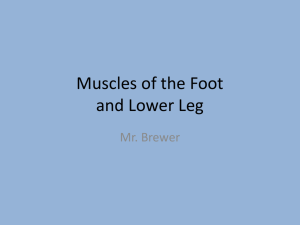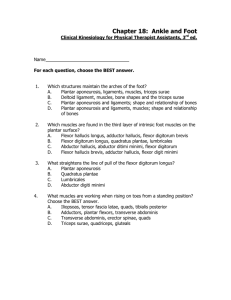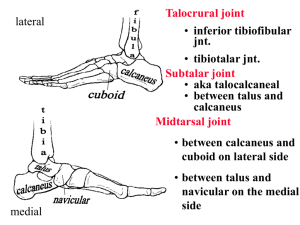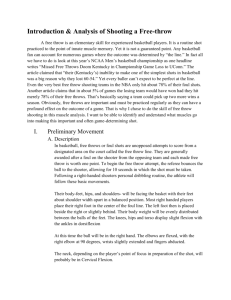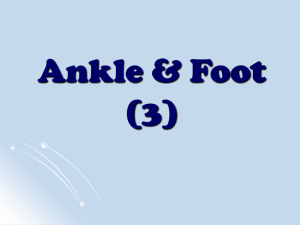Muscles of the Foot and Lower Leg
advertisement
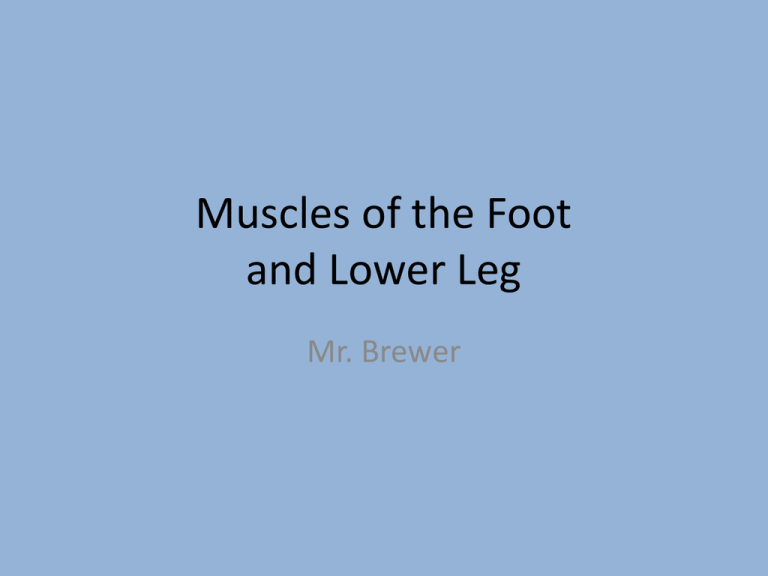
Muscles of the Foot and Lower Leg Mr. Brewer Movements • There are 6 major movements that take place in the lower leg to the foot. • What are they? Movements • The 6 Major Movements that occur at the ankle and foot are: – Plantar Flexion – Dorsi Flexion – Inversion – Eversion – Toe Flexion – Toe Extension Plantar Flexion • Gastrocnemius: – The gastrocnemius is the prime mover for plantar flexion. – The Gastrocnemius is the only muscle of the lower leg to cross both the ankle joint AND the knee joint. – In combination with the soleus, these muscles are referred to as the “calf” muscles. Plantar Flexion - Soleus: - The soleus is located directly under the gastrocnemius. - It is also responsible for plantar flexion, although it acts as an assistant mover with the gastrocnemius for plantar flexion. - Both the Gastrocnemius and Soleus have a distal attachment to the Achilles Tendon. - The Achilles tendon then inserts into the proximal aspect of the calcaneous at it’s most posterior location. Plantar Flexion • Just like most muscles in the body, there are several muscles that contribute to plantar flexion as “assistant movers”. • Most of these muscles are responsible for multiple movements around the joint they are located. • Some additional muscles that also play a role in plantar flexion along with other movement(I.E. Plantar-flexion and eversion): – – – – – Peroneus Longus Peroneus Brevis Flexor Digitorum Longus Flexor Hallicus longus Tibialis Posterior Dorsi-Flexion • Tibialis Anterior – – Located on the lateral aspect of the tibia. – Attaches distally to the mid-foot to dorsi-flex the foot. – Also is responsible for inversion of the foot. Dorsi-Flexion There are 3 additional muscles that play a role in dorsi-flexion, yet they have other primary movements that they are responsible for. Muscles: - Extensor Digitorum Longus - Peroneus Tertius - Extensor Hallucis Longus Inversion • Inversion is the act of a movement in which the plantar surface (sole) of the foot rotates towards the mid-line of the body. • There are 2 major muscles that are responsible for this action. Inversion • Tibialis Posterior : – Primarily responsible for Inversion of the foot. – Also plays a minor role in plantar flexion. – The other muscle that assists in inversion of the ankle is the Tibialis Anterior. Eversion Eversion is the act of a movement in which the plantar surface (sole) of the foot rotates towards the lateral aspect of the body. There is a group of 3 muscles that are primarily responsible for eversion of the foot. Because of the boney and ligament anatomy of the foot, eversion ROM is very limited. (Mostly because of the deltoid ligament) * ROM = Range of Motion (measured in degrees) Eversion • The peroneal muscles are all located on the lateral side of the lower leg, and are primarily responsible for eversion. • The peroneal muscles are also known as “fibularis”. (I.E. Fibularis Longus, Brevis and Tertius) • The Peroneal Muscles: – Peroneus Longus – Peroneus Brevis – Peroneus Tertius Toe Flexion • Toe Flexion is the act of curling your toes towards the plantar surface (ground) • The 2 muscles that are primarily responsible for toe flexion are called: – Flexor Digitorum Longus – Flexor Hallucis Longus Toe Flexion • Flexor Digitorum Longus: – This muscle is the flexor muscle that flexes all 4 lateral toes of the foot. • Flexor Hallucis Longus: – Hallux is the Latin term for the great toe. – The Flexor Hallucis Longus’ primary responsibility is to flex the great toe. Toe Extension • Toe Extension is virtually the opposite of Toe Flexion. • Both in the action of the muscles, and in the naming of the muscles. Toe Extension • Extensor Digitorum Longus: – The extensor digitorum longus is responsible for extending the lateral 4 toes towards the dorsal surface (up). • Extensor Hallucis Longus: – The extensor digitorum longus is responsible for extending the great toe towards the dorsal surface (up). Review 1. What group of muscles is responsible for eversion of the foot? 2. Lifting your heals off of the ground and “standing on your toes” is an example of what ankle movement? 3. What is the only muscle of the lower leg that crosses both the ankle joint and the knee joint. 4. Hallux is Latin for what? 5. The tibialis ___________ is primarily responsible for ankle dorsi-flexion. Review Answers 1. 2. 3. 4. 5. The Peroneals(Fibularis) Plantar-flexion The Gastrocnemius The Great Toe Anterior
